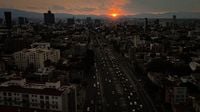The Environmental Commission of the Megalopolis (CAMe) announced on Friday evening, April 25, 2025, that Phase 1 of the environmental contingency for ozone in the Valley of Mexico has been suspended. This marks the fifth ozone environmental contingency in recent months, following similar alerts on February 26, March 18, April 1, and April 23. Additionally, there was a previous alert on January 1 due to poor air quality and suspended particles.
According to CAMe, the meteorological conditions improved significantly after 4:00 PM on Friday. The commission noted, "The atmospheric stability decreased rapidly and the wind increased, allowing better dispersion of pollutants." This improvement was also attributed to the general increase in cloud cover over the Valley of Mexico, which contributed to a continuous reduction in ozone concentrations. By 7:00 PM, the hourly concentrations had returned to acceptable levels.
Looking ahead, CAMe indicated that forecast models predict the high-pressure system currently affecting the Valley of Mexico will move away, leading to even better conditions for pollutant dispersion on Saturday, April 26. Consequently, the environmental restrictions previously announced are being lifted, and the Hoy No Circula program will be implemented as usual.
On Friday, the contingency was activated at 3:00 PM after a maximum hourly ozone concentration of 159 parts per billion (ppb) was recorded at the Ajusco Medio station in the Tlalpan borough. This concentration prompted immediate action from environmental authorities.
As part of the Hoy No Circula program, which aims to reduce vehicular emissions during high pollution days, specific restrictions will be in place on Saturday. From 5:00 AM to 10:00 PM, vehicles for private use with verification hologram 2, as well as those with hologram 1 whose last digit is 2, 4, 6, 8, or 0, will not be allowed to circulate. Additionally, vehicles with verification hologram 0 or 00 and blue stickers ending in 9 or 0 will also face restrictions.
Moreover, 50% of L.P. gas delivery units to stationary tanks without dry disconnection valves will be restricted from circulation, particularly those whose license plates end in an even number. Local and federal cargo vehicles will be prohibited from circulating between 6:00 AM and 10:00 AM, except for those participating in the Self-Regulation Program of Mexico City or the State of Mexico.
For taxis with verification holograms "00," "0," "1," or "2," the restrictions will apply from 10:00 AM to 10:00 PM as per the guidelines issued. However, there are exemptions in place for electric and hybrid vehicles, those with ecological plates, and vehicles designated for urgent medical emergencies.
CAMe emphasized the importance of monitoring air quality and meteorological conditions, stating, "The Environmental Commission of the Megalopolis, the Ministry of Environment and Natural Resources, and environmental authorities in Mexico City and the State of Mexico will remain vigilant regarding air quality and meteorological conditions. We thank the public for following health protection recommendations and emissions reduction measures."
The air quality in the Valley of Mexico varies significantly across different areas. The Atmospheric Monitoring Directorate operates 16 stations in Mexico City and 13 in the State of Mexico, providing ongoing assessments of air quality. Recent reports indicated that areas such as Tlalpan, Benito Juárez, and Coyoacán experienced poor air quality, while other regions like Cuajimalpa and Miguel Hidalgo showed acceptable to good conditions.
In a broader context, air quality is categorized into five levels ranging from "Good" (green) to "Extremely Bad" (purple). The "Good" level indicates minimal health risk, allowing the general population and sensitive groups to engage in outdoor activities without concern. Conversely, the "Acceptable" level (yellow) may cause mild respiratory symptoms in sensitive individuals, while the "Bad" level (orange) significantly increases the risk of respiratory issues for those with pre-existing conditions.
When air quality reaches the "Very Bad" (red) or "Extremely Bad" (purple) categories, authorities recommend that all residents, particularly sensitive groups such as children, the elderly, and those with respiratory or heart conditions, take precautions when engaging in outdoor activities. This includes limiting physical exertion and staying indoors when possible.
As the Valley of Mexico continues to grapple with air quality issues, the recent suspension of the environmental contingency is a positive development. However, the ongoing challenges highlight the need for continued vigilance and adherence to environmental regulations to protect public health.
In summary, the Environmental Commission of the Megalopolis has lifted the ozone environmental contingency in the Valley of Mexico following improved meteorological conditions. As restrictions ease, authorities continue to monitor air quality and urge the public to remain informed and cautious about emissions and health impacts.

